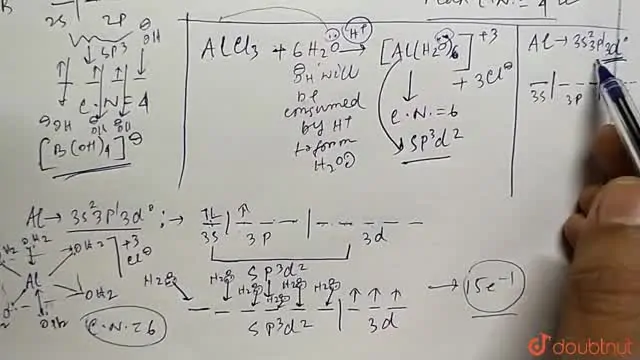When boron trichloride reacts with water, it only forms [B(OH)4]− , whereas aluminium trichloride forms [Al(H2O)6]3+ in acidified aqueous solution. State the hybridisation of boron and aluminium in these species and explain your answer. Solution in Bengali
Boron trichloricfe (BCl3) undergoes hydrolysis to form orthoboric acid [B(OH)3] at first. As atomic size of B is small and its electronegativity is high, B(OH)3 polarises H2O molecule by accepting an OH− ion thereby forming [B(OH)4]−and releasing a proton.
BCl3+3H2O→B(OH)3+3HCl
B(OH)3+H2O→[B(OH)4]−+H+
There are no vacant d -orbitals in B as it lies in the second period and has only one s -and three p -orbitals. So, B can have four pairs of electrons in its valence shell, i.e., its maximum coordination number is 4. For this reason, B(OH)3 accepts one OH− ion to form [B(OH)4]− in which B-atom is sp3 -hybridised. On the other hand, AlCl3 undergoes hydrolysis in acidic medium to form [Al(H2O)6]3+
AlCl3+6H2O→[Al(H2O)6]3++3Cl−(aq)
In acidic medium, concentration of OH− ions is lower than H+ ions. Thus, Al3+ ions coordinate with H2O molecules and not with OH− ions. Due to availability of vacant d -orbitals in Al3+ ions, it can expand its coordination number from 4 to 6. Thus, it can form the complex ion, [Al(H2O)6]3+ in which hybridisation state of Al is sp3d2.
Related Playlists
- BOOK - CHHAYA PUBLICATIONCHAPTER - SOME p-BLOCK ELEMENTSEXERCISE - SOLVED WBCHSE SCANNER35videos
SOME p-BLOCK ELEMENTS
- BOOK - CHHAYA PUBLICATIONCHAPTER - SOME p-BLOCK ELEMENTSEXERCISE - SOLVED NCERT EXERCISE65videos
SOME p-BLOCK ELEMENTS
- BOOK - CHHAYA PUBLICATIONCHAPTER - SOME p-BLOCK ELEMENTSEXERCISE - QUESTION-ANSWER ZONE FOR BOARD EXAMINATION ( SHORT ANSWER TYPE)27videos
SOME p-BLOCK ELEMENTS
- BOOK - CHHAYA PUBLICATIONCHAPTER - SOLID STATEEXERCISE - PRACTICE SET 113videos
SOLID STATE
- BOOK - CHHAYA PUBLICATIONCHAPTER - SURFACE CHEMISTRYEXERCISE - Practice set 513videos
SURFACE CHEMISTRY
Similar Questions
What is producer gas? Write down the reactions for the production of this gas.
01:47View SolutionDiscuss the pattern of variation in the oxidation states of B to Tl.
01:59View SolutionExplain why the B - X bond distance in BX3 is shorter than the theoretically expected value.
01:59View SolutionThe unit cell with crystallographic dimensions, a≠b≠c,α=γ=90∘,β≠90∘ is-
View SolutionThe process by which alum purifies turbid water is
01:04View Solutionwhich of the following compounds are formed when boron trichloride is treated with water?
01:59View SolutionWhen BCl3 is treated with water, it hydrolyses and forms [B(OH)4]− only whereas AlCl3 in acidified aqueous solution forms [Al(H2O)6]3+ ion, Explain what is the hybridisation of boron and aluminium in these species?
05:57View SolutionWhen BCl3 is treated with water, it hydrolyses and forms [B(OH)4]− only whereas AlCl3 in acidified aqueous solution forms [Al(H2O)6]3+ ion, Explain what is the hybridisation of boron and aluminium in these species?
View SolutionWhen acetylene reacts with arsenic trichloride in the presence of anhydous aluminium chloride, it produces
02:55View SolutionBoron forms only ………….. compounds while aluminium forms both ………….. and …………..compounds.
04:07View SolutionWhen BCl3 is treated with water, it hydrolyses and forms [B(OH)4]− only whereas AlCl3 in acidified aqueous solution forms [Al(H2O)6]3+ ion, Explain what is the hybridisation of boron and aluminium in these species?
02:59View Solutionबोरॉन ट्राइक्लोराइड तथा निर्जलीय एल्युमीनियम ट्राइक्लोराइड की संरचनाओं में भिन्नता को स्पष्ट कीजिए।
00:58View SolutionWhich of the following statement(s) is/are incorrect?
(i).Trichlorides on hydrolysis in water form tetrahedral [M(OH)4]− species.
(ii). Hybridisation state of metal in tetrahedral species is sp3.
(iii).Aluminium chloride in acidified aqueous solution forms [Al(OH)4]− ion.View SolutionExplain Sp2 hybridisation taking boron trichloride (BCl3) as an example.
02:47View SolutionAluminium chloride exists as a dimer, but boron trichloride does not. Explain.
04:09View Solution


